ABSTRACT
Following the 7.8 magnitude earthquake that struck Ecuador on 16 April 2016, multiple salient public health concerns were raised, including the need to provide mental health and psychosocial support for individual survivors and their communities. The World Health Organization and the United Nations High Commissioner for Refugees recommend conducting a desk review to summarize existing information, specific to the affected communities, that will support timely, culturally-attuned assessment and delivery of mental health and psychosocial support shortly after the onset of a disaster or humanitarian emergency. The desk review is one component of a comprehensive toolkit designed to inform and support humanitarian actors and their responders in the field.
This commentary provides a case example of the development of a desk review that was used to inform personnel responding to the 2016 earthquake in Ecuador. The desk review process is described in addition to several innovations that were introduced to the process during this iteration. Strengths and limitations are discussed, as well as lessons learned and recommendations for future applications.
Introduction
The earthquake
At 6:58 PM local time on 16 April 2016, the Andean nation of Ecuador experienced one of the most destructive earthquakes in its history (). The final situation report issued by Ecuador's National Secretariat for Risk Management reported that the 7.8 magnitude earthquake resulted in 663 deaths and 6,274 injuries ().Citation1 A total of 113 live rescues were successfully performed. An estimated 28,775 citizens sought emergency shelter.Citation1 The earthquake triggered widespread structural collapse resulting in destruction or severe damage to more than 1,400 buildings (). Economic costs were assessed at USD 3 billion. In the 6-month review of the earthquake response, the United Nations Office for the Coordination of Humanitarian Assistance estimated that 387,000 persons were registered as disaster victims.Citation2
Figure 1. United States Geological Survey (USGS) “PAGER” Summary for the 16 April 2016 Ecuador Earthquake.
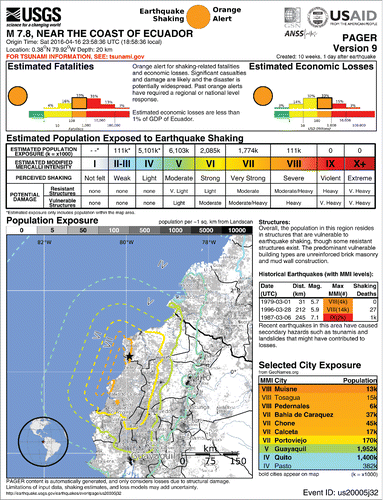
Figure 2. Pacific Disaster Center Map of Ground Shaking Intensity 16 April 2016 Ecuador Earthquake. © Pacific Disaster Center. Reproduced by permission of Pacific Disaster Center. Permission to reuse must be obtained from the rightsholder.
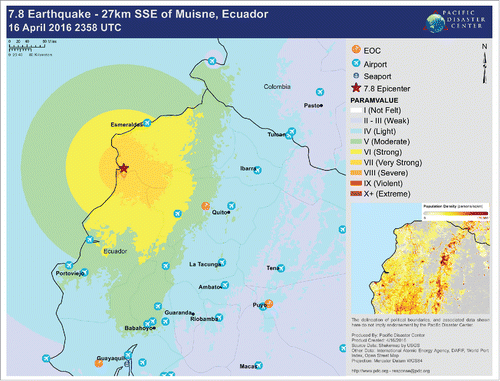
Figure 3. Pacific Disaster Center Map of Earthquake-related Mortality 16 April 2016 Ecuador Earthquake. © Pacific Disaster Center. Reproduced by permission of Pacific Disaster Center. Permission to reuse must be obtained from the rightsholder.
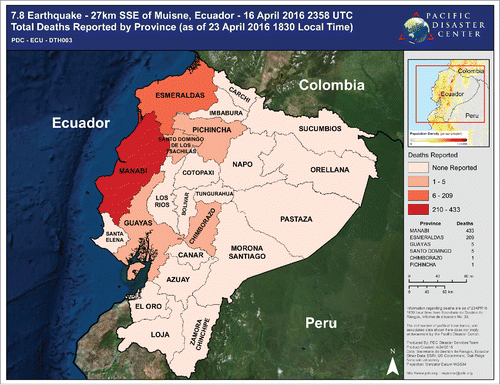
Figure 4. Pacific Disaster Center Map of Earthquake-related Injuries 16 April 2016 Ecuador Earthquake. © Pacific Disaster Center. Reproduced by permission of Pacific Disaster Center. Permission to reuse must be obtained from the rightsholder.
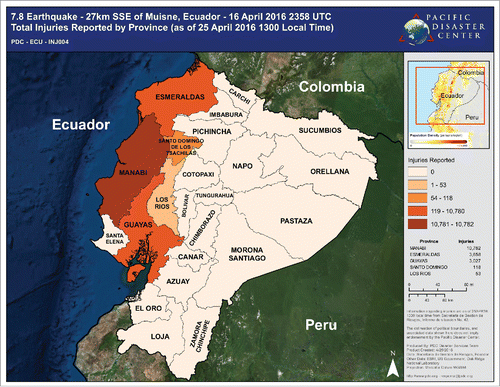
Figure 5. Pacific Disaster Center Map of Earthquake-related Damage to Built Environment 16 April 2016 Ecuador Earthquake. © Pacific Disaster Center. Reproduced by permission of Pacific Disaster Center. Permission to reuse must be obtained from the rightsholder.
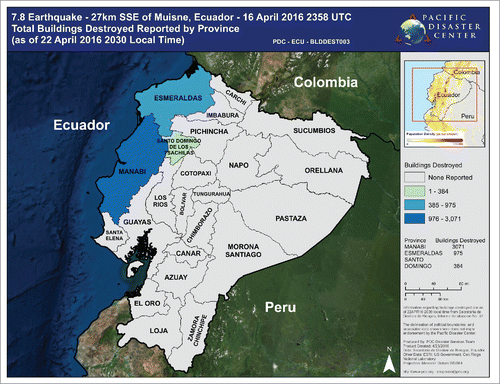
This seismic event activated an international humanitarian response that included Red Cross affiliates from several nations, United Nations agencies and partners, a variety of non-governmental organizations, and medical missions from the United States including physician teams from the University Of Miami Miller School of Medicine, among others. Working in coordination with the Pan American Health Organization (PAHO) and the Inter-Agency Standing Committee's Reference Group on Mental Health and Psychosocial Support (IASC RG-MHPSS), the response elevated psychosocial support in emergency settings to priority status.
Background on Ecuador
As the name signifies, Ecuador is a South American continental nation located in tropical latitudes along the equator. The nation is notable for its biodiversity and rich panoply of ecosystems ranging from high Andes to the tranquil Pacific coastline, and from the Amazon River to the offshore Galapagos Islands. Along Ecuador's west coast, the topography rises vertically from sea level to snow-covered mountain peaks, including the Chimborazo volcano, soaring to an altitude of 20,549 feet. Chimborazo is one of Ecuador's 50 volcanoes that punctuate the nation's mountainous western spine. Ecuador's steep mountain ranges form a segment of the famed “Ring of Fire” that outlines the Pacific Ocean with a circlet of tectonic plate boundaries known for their intense seismicity. Ecuador has a history of generating frequent geophysical events that impact both coastal and mountain-dwelling human populations. Thus, Ecuador is extremely vulnerable to a range of interrelated hazards: earthquakes, tsunamis, volcanic eruptions, landslides, mudslides, and floods.
Not unlike the geography of the region, Ecuador's political history also has a rugged and volatile character. Ecuador is currently operating under its 20th constitution since 1830 when Ecuador became a sovereign republic. In recent times, the presidency changed hands 6 times within one 10-year span, 1996 to 2006. Ecuador is currently home to almost 16 million people with representation from more than 30 different ethnic groups. Mestizos comprise the largest subgroup, accounting for approximately 65% of the population.
Ecuador faces major public health and socio-economic challenges. In recent years, widespread poverty, coupled with wealth inequality, have been compounded by plummeting oil prices on the global market. Although the current twice-elected administration has prioritized social investment, Ecuador's health system and social services remain fragmented.Citation3,4 Non-communicable diseases are increasing in incidence and prevalence. The arrival of the Zika virus epidemic has increased the disease burden and redirected resources away from the routine delivery of public health services for vulnerable citizens and communities. Zika infection and illness are occurring at high rates in the earthquake-affected areas,Citation5-7 Understandably, these interlocking elements of Ecuador's socio-economic, cultural, and political context hampered the nation's capacity to respond in the aftermath of the 2016 earthquake.
Desk review as a tool to inform humanitarian response
As a traumatic, sudden-onset disaster event, an earthquake of this magnitude, occurring in proximity to human populations, demands a rapid, strategic, and informed response to save lives, optimize health, and stabilize the affected region. Internationally, mental health and psychosocial support (MHPSS) services have been increasingly recognized as an integral component of disaster response. However, the nation of Ecuador faced several fundamental challenges to implementing an MHPSS response. Baseline prevalence data for common mental disorders (CMDs) and substance abuse disorders were lacking. The availability of mental health treatment services, facilities, and professionals in the earthquake-impacted region was minimal. Moreover, there was very limited knowledge regarding culturally-acceptable and effective MHPSS and psychiatric interventions and resources.
Desk review is a method developed and recommended by the World Health Organization (WHO) and the United Nations High Commissioner for Refugees (UNHCR) to rapidly synthesize existing literature, both peer-reviewed and unpublished, on the socio-cultural context, mental health and psychosocial consequences experienced during past disaster events, the mental health system, historical experiences with humanitarian response, and information about the current situation for the disaster-affected nation or region.Citation8
The purpose for conducting a desk review is to consolidate existing knowledge on MHPSS within the culture and context of the disaster from a variety of sources such that it may serve as an accessible tool for humanitarian actors to use when making programmatic decisions.Citation8 This analytical exercise also reduces the need for deployable assets—emergency and MHPSS response personnel—to invest time and focus on conducting needs assessments and acquiring information that may already be available.
Research teams from 4 academic institutions, 1) King's College London, 2) University of Miami Miller School of Medicine, 3) Johns Hopkins Bloomberg School of Public Health, and 4) Universidad Complutense de Madrid, were assembled to produce the 2016 Ecuador earthquake desk review.Citation9,10 These research teams were comprised primarily of graduate students specializing in the areas of global mental health, public health, clinical psychology, and medicine. Approximately 30 students participated in the process, guided by leaders in each institution with expertise in the areas of disaster health and MHPSS and/or experience conducting an MHPSS desk review for other complex emergencies. In turn, prior to initiating the process, the desk review leaders consulted with the professionals who had spearheaded the development of the WHO and UNHCR assessment toolkit to clarify procedures and receive their recommendations. For example, one critical piece of guidance was that the 2016 Ecuador earthquake was considered by WHO to be a “category 2” disaster, and the health response was coordinated by WHO's Western Hemisphere affiliate, PAHO, not by the WHO Headquarters office in Geneva.
Also critical was the process of contacting PAHO and IASC's Reference Group for MHPSS. These entities were coordinating the humanitarian response and it was essential to receive permission and encouragement to proceed with the desk review.
The Ecuador desk review followed the structure outlined in the WHO assessment toolkit document.Citation8 Once a plan of action for the desk review was developed, the process became primarily student-led and operated. As has been found in previous reviews employing this personnel structure,Citation11 having large, well-organized and managed student volunteer groups allows for desk reviews to be conducted economically, without overburdening the time and resources of any individual participant. Regular communication and systematic coordination among the four participating institutions was critical for efficient development of this desk review. Another strength of our research teams was that several Ecuadorians and individuals intimately familiar with the local culture and context were represented. The close connection to Ecuador engendered a strong commitment and enthusiasm surrounding the desk review. The desk review created an opportunity for expatriate Ecuadorians—students and faculty members—to contribute instrumentally to the MHPSS response.
As outlined in the WHO assessment toolkit, the desk review began with searches of 5 academic databases focusing on peer-reviewed literature (LILACS, PILOTS, PsycINFO, Pubmed/Medline, Web of Science) and 15 agency websites and databases [ACAPS, ACT Alliance, ALNAP, CBM International, Gestion de Riesgos, International Federation of the Red Cross and Red Crescent Societies (IFRC), International Organization for Migration (IOM), MHPSS.net, Pan-American Health Organization (PAHO), Plan International, Relief Web, Save the Children, United Nations Children's Fund (UNICEF), WHO, and World Vision International (WVI)].
The search strategy varied according to the functionality of each database's search engine. Search terms included “Ecuador,” “Equador,” “health,” “salud,” “psychosocial,” “psych*,” “psico*,” “protec*,” “mental,” and “mental health.” In addition to these data collection methods, we also elected to contact MHPSS experts in Ecuador and humanitarian response organizations known to be active in the response to request additional resources for inclusion in the desk review that may not have been available through one of the aforementioned databases. We liaised with PAHO and the IASC's Reference Group for MHPSS to identify and communicate with the agencies responding to the earthquake in Ecuador.
We prioritized personal communication for several reasons: 1) the 2016 Ecuador earthquake was classified as a category 2 disaster that was largely managed at the regional level; 2) we anticipated that the available literature on mental health and psychosocial well-being in Ecuador would be limited; and 3) we wanted to engage the end-users (i.e. humanitarian responders) in the desk review process early to optimize the utility of the final product.
Searches of all databases, including resources obtained from personal communications, yielded 1,483 documents, of which 195 were determined to be highly relevant. These articles were then reviewed in full and summarized by a member of the research team. The structure of the desk review adhered to the recommended table of contents provided in the desk review toolkit.Citation8 Once completed, the desk review was translated into Spanish. Both versions (English and Spanish) were sent to humanitarian actors working in Ecuador and published online for broader dissemination on 1) mhpss.net (http://mhpss.net/groups/current-mhpss-emergency-responses/emergenciescrisis-briefs/mhpss-desk-review-reports/resources/) and 2) the Mental Health Innovation Network (http://www.mhinnovation.net/resources/desk-review-ecuador-earthquake-revisi%C3%B3n-de-informaci%C3%B3n-terremoto-de-ecuador-2016).
This is one of the first desk reviews to provide a rapid translation into the language of the target population for ease of use by humanitarian responders.
Below we highlight a few of the primary findings from the desk review on MHPSS in the context of the 2016 Ecuador earthquake and discuss their relevance for humanitarian response.
Mental health and psychosocial problems and resources
The epidemiology of mental health and psychosocial problems in Ecuador
The desk review revealed a dearth of published research on mental health effects of disasters in Ecuador apart from the work of one research team dating from the 1990s that described post-traumatic stress and depressive symptoms in natural disaster survivors.12 This finding was consistent with a 2013 WHO report highlighting the elevated risks for mental health problems in Latin America and the Caribbean in the aftermath of natural disasters.13 Fortunately, a PAHO-commissioned study that provides a comprehensive update on the mental health system and services in Ecuador, with a strong focus on the cultural context, is due to be published in 2016.
Cultural conceptions of mental health and psychosocial wellbeing in Ecuador
Examination of relevant constructs such as idioms of distress, concepts of the self, and etiological theories, yielded useful information for addressing MHPSS needs following the earthquake. In Ecuador, the concept of the person tends to be holistic, viewing the individual as a composite of physical, mental, spiritual, and community identities. This notion of the self is particularly prevalent within indigenous communities where mental health problems are believed to result from supernatural causes. When these problems arise, traditional healers (yachactaitas) are consulted.Citation14-19 In contrast, Mestizos, the predominant ethnic group, employ a mixed explanatory model of mental disorders that incorporates elements from both biomedical and supernatural etiological theories. Therefore, Mestizos are more likely to be amenable to receiving western psychiatric and psychological interventions, although not exclusively.
The literature review indicated that prevalent psychological distress in the Ecuadorian population is related to unmet basic needs and the stressors of daily living. Natural disasters exacerbate this distress based on trauma exposures and resource losses for the affected populations.
The clinical presentation of mental health problems and the description of psychological symptoms differ across communities within Ecuador. Expressions that are used by members of indigenous Ecuadorian communities to describe mental health conditions and manifestations do not translate easily into the western psychiatric lexicon or diagnostic systems. In Ecuador, mental health problems frequently present as some form of somatization, particularly featuring gastrointestinal distress and headaches.
Idioms of distress differ by indigenous culture. Nervios is the expression that most closely approximates the western concept of psychological distress. Nervios is a term that refers to a constellation of symptoms that partially overlap with criteria used for diagnosing major depression. Nervios is distinguished from other idioms of distress as describing a normative and non-stigmatizing response to daily stressors.Citation19 The Mestizo population maintains an affinity for describing psychological distress using local idioms (nervios, susto) while also adopting the western nomenclature for psychiatric disorders and syndromes ().
Table 1. Idioms of distress.Citation14,17,19
The formal and informal health systems
Ecuador's constitution declares that free health care is a basic right for all citizens but this is not the reality. Mental health care in Ecuador has historically featured inpatient psychiatric care rather than community-based programs.13 Recent initiatives have attempted a shift toward deinstitutionalization and expansion of public and private mental health services. Although the National Mental Health Strategic Plan 2014–2017 presents comprehensive guidelines for mental health care, no mechanism exists to translate this guidance into actual delivery of care. A severe limitation is the nationwide shortage of trained mental health professionals that persists despite recent efforts from the Ministry of Public Health to employ more specialized practitioners.
Barriers to accessing the formal mental health system are also introduced through cultural norms and help-seeking patterns. Help seeking often first occurs through the non-allopathic health system in Ecuador. The use of herbal and home remedies is common.Citation20 Furthermore, there are many non-allopathic health facilities and providers that operate in parallel to western medical facilities.Citation21,22 This is particularly true for indigenous communities whose members commonly seek care through traditional healers (yachactaitas).Citation15,17
This desk review resource was made available to humanitarian personnel to better inform them about the pluralistic nature of Ecuador's mental health care. Hopefully this information may have assisted humanitarian actors to integrate these systems of care into their acute disaster response operations. More importantly, throughout the prolonged recovery and reconstruction phases when earthquake-related distress and psychopathology are more likely to be observed, this information may also support the development of sustainable linkages for ongoing care.
The role of the education and social sectors in MHPSS
Few services exist outside of the traditional and non-allopathic health systems for prevention and treatment of mental health and psychosocial problems. In the aftermath of previous natural disasters in Ecuador, humanitarian agencies have introduced psychosocial programs into schools and social services that address the root causes of distress, such as loss of livelihoods and safety and security concerns. However, historically, the lifespan of these programs has only extended for the duration of the humanitarian response.Citation23-26
Earthquake response
The number of staff responding to MHPSS during the 2016 earthquake was difficult to estimate due to the chaotic nature of the situation. PAHO and the IASC monitored the agencies that were active in the MHPSS response (). Preliminary reports found that the lack of specialized and non-specialized personnel resulted in unmet mental health needs. Moreover, there was no available evidence indicating that a mid to long-term recovery strategy, incorporating MHPSS, was being pursued.
Table 2. Agencies and organizations providing mental health and psychosocial support (MHPSS) during the 2016 Ecuador earthquake.
Lessons learned and future directions
The findings from this desk review highlight important cultural considerations related to mental health that may inform humanitarian MHPSS programming, including how established formal and informal sources of mental health care are structured, the presence and manifestations of culture-bound syndromes and explanatory models, and differences in the experience and perception of mental health and psychosocial problems for distinct socio-demographic groups within Ecuador.
Limitations of the desk review
Several important limitations of the desk review should be noted. Although a desk review is intended to be broad and inclusive, it is not systematic and thus may not comprehensively describe the MHPSS literature. Moreover, literature on MHPSS in Ecuador was very limited. Furthermore, the existing literature focuses primarily on certain subgroups and is thus not representative of all of the Ecuadorians residing in the earthquake-affected zones. For example, scant literature was available on Afro-Ecuadorians and it is unclear whether the findings from this desk review are generalizable to this population or to other communities not represented in literature identified through our searches. Future research should focus on MHPSS in underrepresented Ecuadorian populations in order to strengthen our understanding of the epidemiology and treatment of mental health and psychosocial problems in Ecuador that will enhance the cultural competency of MHPSS response.
Distinguishing features and contributions of the desk review
This review is the first to summarize MHPSS in Ecuador during an ongoing disaster response. The desk review integrates knowledge on culture and context, the epidemiology and etiological theories of mental health and psychosocial problems, existing services and help-seeking patterns, and both historical and recent experiences with humanitarian response in Ecuador. This review incorporates data from multiple sources, specifically the peer-reviewed literature, agency websites and reports, and personal communication with people engaged in the earthquake response.
This desk review also presents several innovations that should be highlighted. First, following the example of previous desk reviews, this process employed a well-coordinated team of approximately 30 students across multiple institutions, which allowed for manageable distribution of workload as well as a timely turnaround. However, in contrast to previous desk reviews, this particular exercise was almost entirely student-driven, with minimal direct faculty or expert involvement. Only one faculty member at University of Miami and one at Universidad Complutense de Madrid had direct coordination roles and they shared these roles in an egalitarian manner with student leads at King's College London and Johns Hopkins. For future desk reviews, particularly those initiated for “category 2” level disasters (that will garner less international focus and personnel resources), it may be possible to rely on student involvement (particularly students from institutions with connections to the disaster-affected region) in a similar manner.
Second, the act of incorporating Ecuadorian students as project volunteers for the desk review benefitted from their special connection to the country and motivation for participation. Their involvement provided an additional assurance that the material that was summarized in the review was relevant, comprehensive, accurate, and culturally attuned.
Third, in addition to relying on the traditional search databases as primary sources of relevant literature—and motivated by the dearth of available literature specific to Ecuador—the desk review team decided to reach out to the humanitarian response agencies actively working in the field to expand the array and timeliness of disaster-relevant resources incorporated into the review.
Fourth, the decision to translate the desk review into the primary language of the disaster-affected nation (e.g. Spanish for Ecuador) broadened the audience of potential end-users and improved the utility of the final product. Translation allowed Spanish-speaking stakeholders to directly access and use this material. In this desk review, the primary focus of the team at the Universidad Complutense de Madrid was to accomplish this task in a timely manner (the team completed the translation in 3–4 weeks).
Concluding comments
As one of the key assessment tools for MHPSS response in emergency settings, the act of conducting a rapid desk review “packages” critical, extant information and resources for timely application by decision-makers who are coordinating the operations, and onsite personnel who are actively engaged in disaster response and recovery.
The innovations discussed in this commentary may further improve the development, dissemination, and uptake of future desk reviews as well as provide a foundation for updates in the event of future disasters in Ecuador. The results of the desk review highlight the complexities involved in developing MHPSS programs that are grounded on the best evidence-based science, concordant with explanatory models, and carefully adapted to the diversity of cultures represented among the disaster-affected populations. Also challenging is the ability to prioritize MHPSS and to dovetail psychosocial interventions effectively into pluralistic health systems.
Importantly, this desk review revealed the lack of research on MHPSS in this region. In Ecuador, as well as many other nations affected by humanitarian emergencies, there is a great need for additional research on MHPSS,Citation27 particularly in ethnic minorities and populations seeking mental health services outside of the formal health system. Desk reviews provide an opportunity, not only for informing the humanitarian response to the urgencies of the immediate emergency, but also for elucidating important systemic gaps in mental health knowledge, services, and staffing.
Disclosure of potential conflicts of interest
No potential conflicts of interest were disclosed.
Funding sources
Ms. Greene is supported by the National Institute on Drug Abuse (NIDA) under grant T32DA007292. Ms. Troya is supported by the Keele University ACORN studentship, and was also supported by SENESCYT Ecuador Becas de Excelencia 2015 under grant No. 063-CIBAE-2015 during the 2015–2016 academic period.
Acknowledgments
We thank the following persons for contributing to data collection, screening and synthesis for the desk review: Natalie Ann Cain, James Patrick Ennen, Yanira E. Garcia-Barcena, Matthew Scott Heller, Katherine Masih, Rachel McKean, Zsuzsanna Nemeth, Daniel Martin O'Shea, Denisse Cristina Pareja V., Carlos Mario Parra, and Nelson Sanchez (University of Miami Miller School of Medicine); Farnoosh Ali, Victor Cabezas, Alvaro Chiriboga, Melissa Co, Lakshmi Gopalakrishnan, J. Esteban Guzman, Sarah Hartman, Valentina Lucio Paredes, Sarah Oeffler, Mateo Saenz, Zainab Sulaiman, and Andrea Yandun (King's College London & London School of Hygiene and Tropical Medicine); and Daniel Hostetler (Johns Hopkins Bloomberg School of Public Health). We also thank affiliates of Universidad Complutense de Madrid for assistance in translating the desk review into Spanish: Pedro Altungy Labrador, Rocio Fausor de Castro, Maria Paz Garcia Vera, Noelia Moran Rodriguez, and Ana Silvia Salazar Zetina.
We would also like to thank Drs. Ricardo Araya, Mark Jordans, Brandon Kohrt, Wietse Tol and Mark van Ommeren for their guidance related to desk review procedures.
References
- Secretaria de Gestion de Riesgos. Situacion general desde crisis sismica 16 de Abril. 2016. Quito, Ecuador: Secretaria de Gestion de Riesgos; 2016 May. 15 p. Report No. 71. Available from http://www.gestionderiesgos.gob.ec/wp-content/uploads/downloads/2016/05/INFORME-n71-SISMO-78-20302.pdf. Accessed 14 November 2016.
- UN Office for the Coordination of Humanitarian Affairs. Ecuador Terromoto 16 Abril 2016. Informe a Seis Meses. 2016 Oct. 18 p. Available from http://reliefweb.int/report/ecuador/ecuador-terremoto-informe-seis-meses-13-de-octubre-2016. Accessed 14 November 2016.
- Malo M. Reforma del Sistema de Salud del Ecuador: hacia la cobertura universal. 2014. Located at: PAHO, Lima, Ecuador. Available from http://www.paho.org/forocoberturagt2014/wp-content/uploads/2014/08/Reforma-del-Sistema-de-Salud-del-Ecuador-hacia-la-Cobertura-Universal.pdf
- Ministerio de Salud Publica. Modelo de Atencion de Salud Mental en el marco del modelo de Atencion Integral de Salud (MAIS) con enfoque familiar comunitario e intercultural. 2014. Located at: Ministerio de Salud Publica, Quito, Ecuador. Available from http://www.confbasaglia.org/wp-content/uploads/2015/01/Modelo-de-Atenci%C3%B3n-de-Salud-Mental-FINAL-julio-2014.pdf
- ACAPS. ACAPS Briefing Note: Ecuador earthquake-18 April 2016 [Internet];2016 May 15. Available from http://reliefweb.int/report/ecuador/acaps-briefing-note-ecuador-earthquake-18-april-2016
- United Nations Children's Fund. Twelvefold increase in Zika cases since Ecuador earthquake [Internet]; 2016 August 1. Available from www.unicef.org/media/media_91912.html
- World Health Organization. Countries: Ecuador [Internet]. Geneva: World Health Organization; 2016 November 4. Available from http://www.who.int/countries/ecu/en/
- World Health Organization, United Nations High Commissioner for Refugees. Assessing mental health and psychosocial needs and resources: toolkit for humanitarian settings. 2012. Available from http://www.who.int/mental_health/resources/toolkit_mh_emergencies/en/
- Inter-Agency Standing Committee (IASC) Reference Group for Mental Health and Psychosocial Support in Emergency Settings. Ecuador Earthquake 16 April 2016: Desk Review of Existing Information with Relevance to Mental Health and Psychosocial Support. Miami, USA; London, UK; Baltimore, USA; Madrid, Spain: Inter-Agency Standing Committee; 2016 Jul. 62 p. Available from http://mhpss.net/?get=290/ecuador-earthquake-mhpss-desk-review-final_english_19.07.2016.pdf
- Inter-Agency Standing Committee (IASC) Reference Group for Mental Health and Psychosocial Support in Emergency Settings. Terremoto de Ecuador 16 de abril de 2016. Revisión de información relevante para la Salud Mental y el Apoyo Psicosocial (SMAPS). Miami, USA; London, UK, Baltimore, USA; Madrid, Spain; Inter-Agency Standing Committee; 2016 Jun. 64 p. Available from http://mhpss.net/?get=290/deskreviewspanishcorrected.doc-1.pdf
- Inter-Agency Standing Committee (IASC) Reference Group for Mental Health and Psychosocial Support in Emergency Settings. Nepal Earthquakes 2015: Desk Review of Existing Information with Relevance to Mental Health and Psychosocial Support. 2015. Available from https://interagencystandingcommittee.org/system/files/20150622_nepal_earthquakes_mhpss_desk_review_150619.pdf., Kathmandu, Nepal.
- Lima B. Psychiatric Disorders among emotionally distressed disaster victims attending primary mental health clinics in Ecuador. PAHO Bulletin 1992; 26(1): 60-66.
- Pan-American Health Organization. WHO-AIMS: Report on Mental Health Systems in Latin America and the Caribbean. 2013. PAHO, Washington, D.C. Available from http://www.paho.org/hq/index.php?option=com_docman&task=doc_view&gid=21325&Itemid=270
- Armijos C, Cota I, González S. Traditional medicine applied by the Saraguro yachakkuna: a preliminary approach to the use of sacred and psychoactive plant species in the southern region of Ecuador. J Ethnobiol Ethnomed 2014; 10(26); PMID:24565054; http://dx.doi.org/10.1186/1746-4269-10-26
- Chelala C. Health in the andes: The modern role of traditional medicine (Part I). Quito-Ecuador: Registro Oficial 2009; 449:20-10.
- Cruza-Guet MC, Spokane AR, Leon-Andrade C, Borja T. Diversity, hegemony, poverty, and the emergence of counseling psychology in Ecuador. International handbook of cross-cultural counseling. 2009; 393-324.
- Incayawar M. Efficacy of Quichua healers as psychiatric diagnosticians. Br J Psychiat. 2008; 192(5):390-391; PMID:18450668; http://dx.doi.org/10.1192/bjp.bp.107.046938
- León C, Lozano A. Raíces culturales de la psiquiatría en el Ecuador [Cultural roots of psychiatry in Ecuador]. Revista Electrónica de Psiquiatría. Retrieved May 20, 2016. Available from http://www.psiquiatria.com/revistas/index.php/psiquiatriacom/article/viewFile/142/127
- Yusim A, Anbarasan D, Hall B, Goetz R, Neugebauer R, Ruiz P. Somatic and cognitive domains of depression in an underserved region of Ecuador: some cultural considerations. World Psychiatry 2009; 8(3):178-80; PMID:19812756; http://dx.doi.org/10.1002/j.2051-5545.2009.tb00247.x
- Miles A. Radio and the commodification of natural medicine in Ecuador. Soc Sci Med 1998; 47(12):2127-2137; PMID:10075252; http://dx.doi.org/10.1016/S0277-9536(98)00276-7
- Caselli I. Ecuador hospital mixes folk and modern medicine [Internet]; 2016 June 19. Available from http://www.bbc.co.uk/news/world-latin-america-18483584
- Where International. Alternative Healthcare in Ecuador [Internet]; 2016 June 19. Available from http://whereinternational.com/news/alternative-healthcare-in-ecuador.html
- MSF. People very scared [Internet]; 2016 May 29. Available from http://www.msf.org/en/article/earthquake-ecuador-%E2%80%9Cpeople-are-very-scared-many-have-had-leave-their-homes%E2%80%9D
- Acción Hambre. Calor miedo mosquitos desplazados [Internet]; 2016 May 9. Available from https://www.accioncontraelhambre.org/es/ecuador-el-calor-el-miedo-los-mosquitos-y-la-falta-de-agua-y-alimentos-golpean-los-desplazados-por
- Acción Hambre. Hemos visto mucho miedo [Internet]; 2016 May 9. Available from https://www.accioncontraelhambre.org/es/terremoto-ecuador-hemos-visto-mucho-miedo-pero-nos-tememos-que-todavia-no-hemos-visto-lo-peor
- Acción Hambre. Personas que piden ayuda sigue aumentando [Internet]; 2016 May 9. Available from https://www.accioncontraelhambre.org/es/terremoto-ecuador-el-numero-de-personas-que-piden-ayuda-sigue-aumentando
- Tol WA, Barbui C, Galappatti A, Silove D, Betancourt TS, Souza R, Golaz A, Van Ommeren M. Mental health and psychosocial support in humanitarian settings: linking practice and research. The Lancet 2011; 378(9802):1581-1591; http://dx.doi.org/10.1016/S0140-6736(11)61094-5

